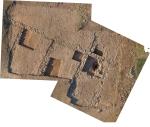Summary (English)
In July 2023, MAP returned to the field for its 6th season of excavation. The project reopened Area 21000 where in 2022 the remains of a circular installation built with large limestones bonded with abundant mortar were discovered inside a large masonry structure.
This year’s investigation confirmed that this installation functioned as a Roman well, which had a rectangular external shape and a circular internal one with a diameter of ca. 1 m. Additionally, a new Area 22000 was opened directly to the west of Area 21000 to expand the investigations of this zone and to understand the phasing and function of a large NW-SE structure with rooms opening to the SW. Three new rooms were documented to the west of the room with the well. The structure seems to have had two phases: an initial construction phase (1st c. B.C. to the 1st c. A.D.) and a second phase during which the rooms were filled with earth mixed with materials from a dump, presumably to raise the level of the floors, and the walls were partially rebuilt with mortar (after the end of the 1st c. B.C. to the mid-1st c. A.D.).
Finally, a small sondage was reopened in Area 10000 inside the apse of the medieval church that was partially excavated by the Roman Peasant Project in 2012. We returned to this Area with the goal of exploring the eastern portico of the opus reticulatum complex, whose northern wing we excavated in previous seasons. Here we once again encountered evidence of the violent fire that destroyed the complex in the mid-1st c. A.D. Under a thick layer of mudbrick collapse, excavators recovered agricultural tools (e.g., a sickle), which seem to have been stored here at the time of the fire.
- Rhodora G. Vennarucci, University of Arkansas
Director
- Astrid Van Oyen, Radboud University
Team
- Amy Walsh
- Cleo Barbafiera, University of Siena
- Rhodora G. Vennarucci, University of Arkansas
- Gijs W. Tol, University of Melbourne
- Matteo Faraoni, University of Siena
- Thomas Keep, University of Melbourne
Research Body
- Cornell University (dall’anno 2017)
Funding Body
- Loeb Classical Library Foundation Grant (PI: Van Oyen)
- Radboud Institute for Culture and History
- University of Arkansas’ Connor Endowed Faculty Fellowship (Vennarucci)
- University of Melbourne (Tol)






![Download [PDF]](/excavation/skins/fasti/images/results/download_sml.png)
